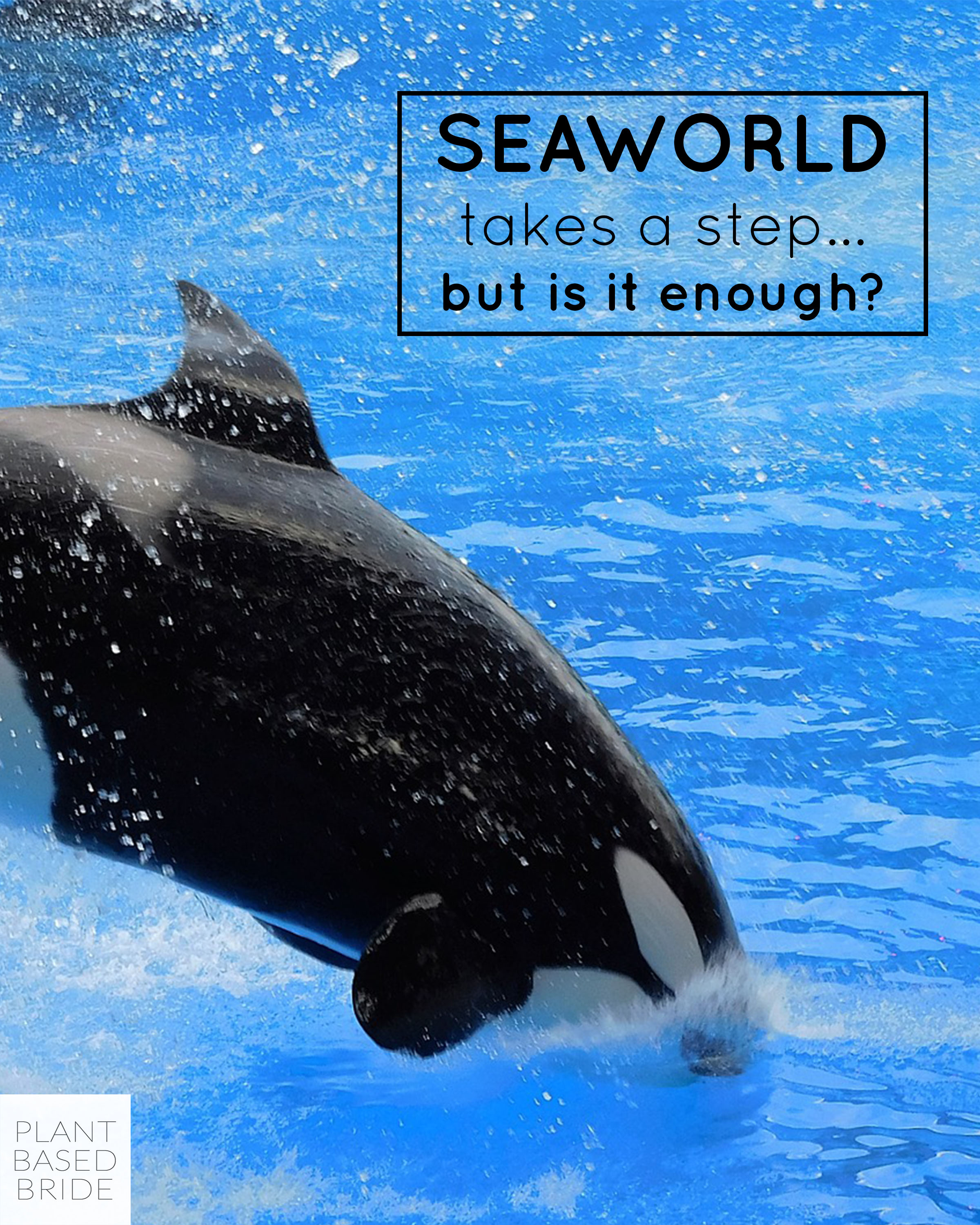SeaWorld Takes A Step... But Is It Enough?
I was elated to hear the recent news that SeaWorld has agreed to end their orca breeding program effective immediately. This decision has come far too late but gives me hope that the tides are changing for the animals who share our planet.
However, I can't help but wonder, is this decision enough to make a real difference to the whale populations already living in these parks?
I'm not so sure.
SeaWorld's Breeding Program
Artificial insemination of orcas began in the year 2000, touted as a means of diversifying the gene pool. However, it shortly became clear that the motives rested more on potential profit from baby whales than on conservation efforts.
There were many issues with the breeding program at SeaWorld, not the least being inbreeding (such as between mother and son) which would never happen in the wild. They also routinely removed the calves from their mothers after at most a couple of years. In the wild a mother and child would remain together for the entirety of their lives.
Another problem with the program? Female orcas were impregnated much younger than their wild counterparts. While the average age of first pregnancy in the wild is 14.9 years, time after time captive whales were giving birth as young as 8 years old. This may or may not be a factor in the numerous miscarriages and still births recorded in captivity.
There has been additional criticism over the fact that SeaWorld has repetitively bred aggressive animals, including Tilikum - the whale featured in Blackfish who has been the cause of three human deaths - resulting in 21 calves.
Conservation
SeaWorld has stated repeatedly over the years that keeping orcas in captivity is a conservation effort - maintaining population numbers and caring for orcas who are unable to survive in the wild.
However, there are several issues with this claim:
- Orcas are not an endangered species according to the WWF;
- Breeding and capturing orcas only to keep them in captivity for the entirety of their lives may artificially raise population numbers but does nothing to maintain a thriving population of orcas in the wild (where they belong);
- Attempts to release orcas kept in captivity for extended periods often fail, as their captive environment doesn't allow the development of natural behaviours and instincts needed for survival in the wild;
- Studies conducted on captive whales cannot be extrapolated to wild whales due to the many differences they exhibit compared to their counterparts living in their natural environment and family groups;
- Captive orcas do not live as long as orcas in the wild. Granny, a 103 year old orca, lives in the pacific ocean with her children, grandchildren, and great-grandchildren in a pod. The oldest orca in captivity is Corky, a 51 year old female captured in 1969 along with 5 other whales, who are now all dead, and held at SeaWorld San Diego.
It has become increasingly clear that the benefits of maintaining captive orca populations are far more financial than conservational.
Treatment of Orcas in Captivity
In this fascinating essay written by John Hargrove, a former trainer at SeaWorld, he expresses his horror at what was done to these incredible creatures for over a decade:
'I saw and did things that haunt me to this day. I realized that we were exploiting these whales for enormous profit and disguising it as education and conservation.'
What was Hargrove referring to?
- Physical and emotional symptoms of stress and boredom due to captivity including:
- Biting steel gates, causing their teeth to fracture and break off, and the corners of their concrete tanks, wearing their teeth down to the point of requiring holes to be drilled into them for irrigation by metal catheter;
- Extended periods of listless floating leading to complete dorsal fin collapse in some females and in 100% of males, something that occurs in less than 1% of adult males in the wild, due to unnatural amounts of time spent at the surface;
- Amplified aggression against other whales and humans, rarely if ever seen in the wild, and;
- Obsessive and repetitive behaviours such as circling a pool for hours on end.
- The distribution of huge amounts of drugs such as:
- Antibiotics to combat frequent infection;
- Drugs to treat fungal infections and ulcers;
- Medication for epilepsy, and;
- Valium for invasive procedures, moving whales from park to park, and removing calves from their mother.
- The removal of whales from their families, even those born in captivity;
- The unnatural habitat made up of small concrete pools devoid of the sounds, smells, and experiences enjoyed in the wild, and;
- The deaths of many orcas far before their time:
- Many stillborn babies, and;
- Numerous deaths of whales in their teens or younger due to infections and other health problems.
Blackfish Brings Controversy
Blackfish, an American documentary released in 2013, centres around Tilikum, an orca captured off the coast of Iceland in 1983 and involved in the deaths of three people: a part-time trainer named Keltie Byrne in 1991, a trespasser names Daniel Dukes in 1999, and an experienced trainer named Dawn Brancheau in 2010.
The film brought attention to the many attacks over the years by captive whales, a conservative estimate sitting at 35 attacks resulting in 4 fatalities since the 1960s. Orcas attacking humans is not common behaviour in the wild, where only 6 threats and attacks have been recorded since the 1910s, resulting in zero deaths.
John Hargrove said in response to the 2010 attack on Dawn Brancheau:
'We will never know why Tilikum made the decision to grab Dawn, pull her in, and dismember her, but what we do know is that it was an aggressive attack. These are wild apex predators.'
The film brought about major public outrage over the treatment and conditions of captive orcas. SeaWorld claimed they had no knowledge of the dangers associated with close contact with orcas, which has been disputed by trainers within the organization. Judge Ken Welsch stated:
'No reasonable person... would conclude that SeaWorld was unaware that working in close contact with killer whales during performances creates a hazard for its trainers.'
There has been increasing pressure from animals rights groups and the public since the film's release for improvement in the living conditions for whales in captivity, the dismantling of SeaWorld's breeding program, the end of theatrical shows involving orcas, and the release of captive animals to the wild.
The Future of Orcas in Captivity
On March 17th, 2016 and in partnership with the Humane Society of the United States (HSUS), SeaWorld acquiesced to the numerous pleas to end their orca breeding program for good.
This means the current population of captive whales held by SeaWorld, 29 orcas in total, will be the last generation of orcas in captivity, with one small caveat. One of the female orcas housed at SeaWorld named Takara is currently pregnant, meaning at least one more whale will be born in captivity.
It was also announced that SeaWorld intends to phase out their theatrical orca shows in favour of more 'natural' displays for visitors beginning as early as 2017. In the Humane Society's press release, Wayne Pacelle, the president and CEO of HSUS, said:
'These two organizations have been long-time adversaries, but we're excited now to see the company transforming its operations for the better on animal welfare. Today's announcement signals that the era of captive display of orcas will end and that SeaWord will redouble its work around rescue and rehabilitation of marine mammals in crisis and parter with us to tackle global threats to marine creatures.'
While this announcement will not cause immediate change in the parks, it is most definitely a move in the right direction for our planet's orcas.
The park released a statement saying:
'Society is changing and we’re changing with it. SeaWorld is finding new ways to continue to deliver on our purpose to inspire all our guest to take action to protect wild animals and wild places.'
So What's Next?
SeaWorld has announced that they do not plan to release their (soon to be) 30 orcas into the wild, stating that they would not be able to survive in their natural habitat after years (or entire lifetimes) in captivity.
This is troubling, as these 30 whales will live as many as 50 or 60 years without ever feeling the sun on their backs as they swim through the waves, hunting for prey, traveling hundreds of miles each and everyday, and creating lifelong family bonds in a pod.
Further, how will SeaWorld prevent accidental pregnancy in their whales, or will they leave it to chance?
Will they continue to improve the living conditions of these whales?
I don't wish to diminish the incredible step that SeaWorld is taking, and agree with both Dr. Naomi Rose, a marine mammal scientist with the Animal Welfare Institute, who said:
'This is a first, massive step forward toward a more humane future for SeaWorld. I welcome these commitments from Joel Manby. He has given SeaWorld a new lease on life.'
And Gabriela Cowperthwaite, director of Blackfish, who stated:
'This is a defining moment. The fact that SeaWorld is doing away with orca breeding marks truly meaningful change.'
But I can't help but wonder, is it enough?
Sources & Further Reading
http://www.vox.com/2016/3/22/11275970/seaworld-orca-killer-whale
https://www.thedodo.com/5-reasons-why-seaworlds-orca-b-531056663.html
http://www.vox.com/latest-news/2016/3/17/11256958/seaworld-killer-whales
http://www.bornfreeusa.org/facts.php?p=2688&more=1
https://www.worldwildlife.org/species/directory?direction=desc&page=2&sort=extinction_status
https://www.thedodo.com/recently-spotted-103-year-old--547381307.html
http://uk.whales.org/wdc-in-action/corkys-story
https://en.wikipedia.org/wiki/Killer_whale_attacks_on_humans
https://www.thedodo.com/seaworld-stop-breeding-orcas-1667873084.html
http://www.humanesociety.org/news/press_releases/2016/03/orca-release.html?credit=tw_post031716?



























